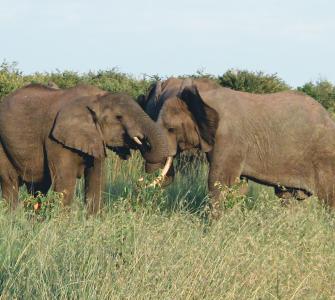Illegal wildlife trade (IWT) has become a major threat to the iconic wildlife species of Southern Africa, driven by high market values on the black market. IWT is now considered to be the world’s fourth largest internationally-organized crime, generating between USD $7 and $23 billion every year. Additionally, the COVID-19 pandemic led to a complete halt in wildlife tourism in Southern African, leaving community conservation – a key element of wildlife crime mitigation – with little or no resources. Wildlife crime undermines the economic prosperity of countries and communities in the region, deteriorating their natural capital, social stability and cohesion, and threatening sustainable economic development, including the erosion of benefits derived from legal nature-based enterprises like tourism.
A lack of reliable data means there is only limited evidence of the impacts of IWT on national and regional economies in Southern Africa. Further evidence is needed not only on the loss in financial values associated with wildlife but also on the gains from protecting it. These data sets are useful to better understand the social and economic implications of IWT and raise awareness among decision-makers to help them design more effective mitigation measures.
Conservation Strategy Fund (CSF) partnered with the Namibian Nature Foundation to provide information on the current state of knowledge of IWT and the economics of IWT in Southern Africa. The project piloted a cost benefit analysis (CBA) tool to support the combatting of IWT in Namibia, while considering the new challenges raised by the sudden drop in tourism and increasing poaching risks in the context of the global COVID-19 pandemic.
Specifically, the analysis resulted in a state of knowledge report on the economic impacts of IWT (especially ivory, rhino horn, lion bone, and pangolin scales) on national and regional economies in Southern Africa. This review noted the many knowledge gaps there are, including on impacts to ecosystem services, the real costs of IWT, and the revenue flows that leak outside the country. The CBA showed that Namibia is currently spending about US$17 million annually to stop IWT and these investments translate into benefits of about US$122 million. If these investments were to stop, Namibia could expect economic losses of about $350 million over ten years. On the other hand, if poaching was successfully curbed, economic benefits are expected to increase by more than US$260 million over ten years. The tool created in this project can forecast economic impacts based on different poaching rates, wildlife population size, tax rates, and prices. Through this project, CSF hopes to raise awareness on the use of economics to fight IWT for better decision-making at the policy and practice levels.
Read our publications below:
- Cost Benefit Analysis: Methods and Metrics for Curbing IWT in the SADC
- State of Knowledge on Impacts of Illegal Wildlife Trade on National Economies in Southern Africa
- The Costs and Benefits of Curbing Illegal Wildlife Trade in Southern Africa Results for Namibia
Watch this video for a summary of our Namibia case study.
This work was part of the VukaNow project, financed by the United States Agency for International Development (USAID) and implemented by Chemonics International Inc.
Photo Credit: Lauren Richards

